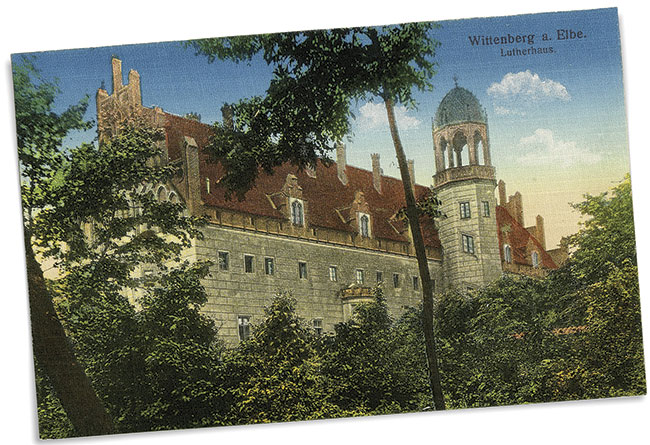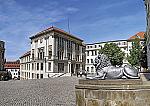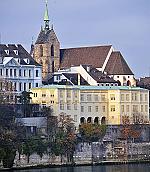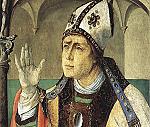The backwoods school that changed a continent

[ABOVE—Lutherhaus, Wittenberg Postcard, 1914—Brück & Shon Kunstverlag Meißen / [CC0] Wikimedia]
In 1502 a university opened in the small town of Wittenberg, far from academic and cultural centers. Dubbed the Leucorea, a Greek word meaning “White Mountain” (Witten Berg in German), it began with just a few hundred students, a handful of faculty (some stolen from nearby Erfurt), and borrowed rooms.
It seemed unlikely that anything would come from such an inauspicious beginning—despite the grand Greek name in the humanist style. But the University of Wittenberg survived and grew to national and even international prominence—it has about 20,000 students and 350 faculty today. Now Martin Luther University of Halle-Wittenberg, it is inextricably linked to the Protestant Reformation and to the man whose name it bears: Martin Luther (1483–1546).
Luther jumps ship
Left without a university because the nearby school at Leipzig (see pp. 20–22) was under the oversight of a different branch of his family, Elector Prince Frederick III (1463–1525) desired a university of his own. Every good Renaissance prince (especially one referred to as “the Wise”) needed a university to provide him with court officials and jurists, not to mention prestige; and every region needed a place of higher learning where men could prepare for careers in law, medicine, theology, and education.
Wittenberg was a suitable if rough location, and so, with the help of Augustinian friar Johann von Staupitz (c. 1460–1524) and Frederick’s doctor (and professor of medicine in Leipzig) Martin Pollich von Mellerstadt (1455–1513), the university was established. Staupitz, first dean of the theology faculty and lecturer in Bible, staffed the college with Augustinians; he brought young faculty as well as many students to Wittenberg to establish an Augustinian friary in the town and their own theology faculty to train its members.
The already-famous university at Tübingen provided a number of early professors as well as the statutes under which Wittenberg was established. Students and faculty also came from a closer school at Erfurt (where Luther was studying), displeasing leaders there. Staupitz brought the promising young Luther to Wittenberg in 1511 to lecture and take the first steps toward his doctorate. Angered by Staupitz’s poaching, the theology faculty at Erfurt at first refused to recognize those first steps as legitimate, briefly putting Luther’s pursuit of his doctoral degree in danger.
Conflict and competition drove the universities of early modern Europe, and Wittenberg was a small school among giants. However, as new intellectual currents reached the German Empire and the northern Renaissance launched, Wittenberg produced great intellectual ferment and strong support for emerging church, social, and political reforms.
The young organizer
At its founding the university was still quite traditional. Aristotle and other customary scholastic texts formed the basis of arts education, the beginning course of study for all students. (For more on scholasticism and humanism, see pp. 6–11.) Students also faced the trivium (grammar, logic, rhetoric) in their bachelor’s and master’s level courses before moving on to higher faculties. As at Paris centuries before, theological studies remained scholastic in nature, focused on the Sentences of Lombard and the books of the Bible.
However, humanists and humanistically inclined faculty influenced theological studies from the beginning. Humanist tendencies toward the priority of ancient languages and original texts informed Luther’s own academic lectures on the Psalms and the letters of Paul, and on his understanding of biblical interpretation.
After his appointment to the chair of Bible in the 1513–1514 academic year, Luther began to push for a reform of the university’s curriculum, particularly in theological studies but also in the arts. Luther knew that new approaches in theology required a new basis of education in ancient languages, among other subjects. But he was not suited to the practical administration of such an undertaking. Fortunately he had just met someone who was.
Philipp Melanchthon (1497–1560) took up the post of professor of Greek in 1518 at the age of 21, and he and Luther quickly became a dynamic duo of university—and then churchwide—reform. (Luther’s 95 Theses burst on the scene shortly before Melanchthon arrived.) The young man’s inaugural lecture addressed ways to reform the university curriculum. Faculty (including early supporters of Luther) moved to incorporate these insights into the curriculum.
Unlike Italian universities with more casual and haphazard structure, northern universities like Wittenberg were well organized, with faculty senates, deans, and rectors who had power to make academic policy and decisions. Melanchthon served as rector in 1523 and 1524, allowing him to take charge of curriculum reform. He introduced Greek and Hebrew as independent subjects while revamping studies of Aristotle to incorporate new, humanist translations of Aristotle’s works. Rhetoric, history, and poetics were added to the arts course, and higher curricula were also modified to remove some scholastic influence and focus on new critical sources of learning. Before long, texts by Wittenberg faculty themselves, such as Melanchthon’s Loci Communes (1521) and, after 1530, the Augsburg Confession, became required.
Hand-in-hand with university reform went Luther’s reform of the church, with support from his fellow faculty and from his prince. After the death of Frederick the Wise in 1525 and the ascension of John (and eventually his son John Frederick) to the electorate, Luther had explicit princely support for his reform and church-building efforts. As was generally true throughout Europe, rulers enforced their university and its theology faculty being constituted along reforming lines.
Wittenberg quickly rose as the focus of this new movement, attracting students not only from around Germany, but also internationally. These students carried their new knowledge and their humanistic and theological commitments
back to their own communities or to new towns where they worked.
Come study with the man himself
Young men from the middle classes enrolled to seek knowledge and greater opportunities. Unlike in other parts of Europe, students in Germany could not expect to find court or church positions, which were few. Thus many sought only basic degrees in the arts. These degrees allowed students to become tutors or teachers in Latin schools, where their influence multiplied; after the Reformation, such men also prepared for jobs as pastors. Students who did seek higher degrees often became university professors themselves; many became leaders in Lutheran, Calvinist, and Swiss reform.
Students continued to flock to Wittenberg, especially after Luther began gaining notoriety. Wittenberg became the largest university in Germany in 1520 and, apart from turmoil during war (1524–1525) or plague (especially 1527), remained so for the rest of Luther’s life. Luther might see up to 400 students in his lecture hall, and Melanchthon from 400 to 600, which constituted the great majority of the student body.
Former students remained connected through ties of friendship and loyalty to the university and other alumni, sharing ideas and commitment. While Luther might have been responsible for the spark that set the Protestant Reformation ablaze, Wittenberg’s students fed the fire and kept it burning. Luther’s brand-new, backwoods school cannot be forgotten in the larger history of the Christian church. CH
By Beth Kreitzer
[Christian History originally published this article in Christian History Issue #139 in 2021]
Beth Kreitzer is history department head at Fusion Academy South Bay in Hermosa Beach, California.Next articles
Tolerant and pious
How Friedrichs University in Halle gave Europe a Pietist vision of the common good
Douglas H. ShantzChristian History Timeline: Godly learning, godly teaching
Christians through the centuries have wrestled with how to educate moral and virtuous people. Here are some milestones along the way.
the editorsSupport us
Christian History Institute (CHI) is a non-profit Pennsylvania corporation founded in 1982. Your donations support the continuation of this ministry
Donate







